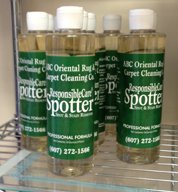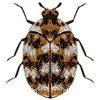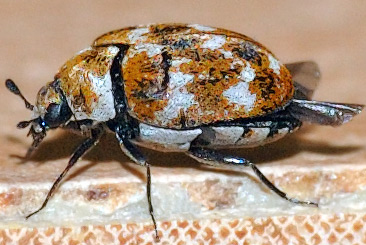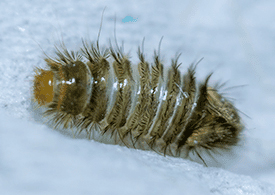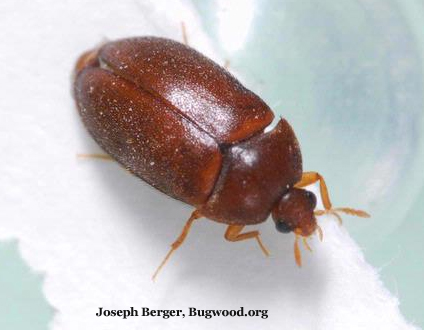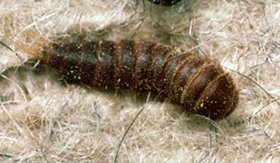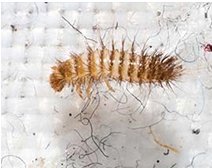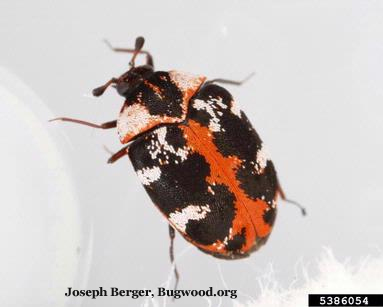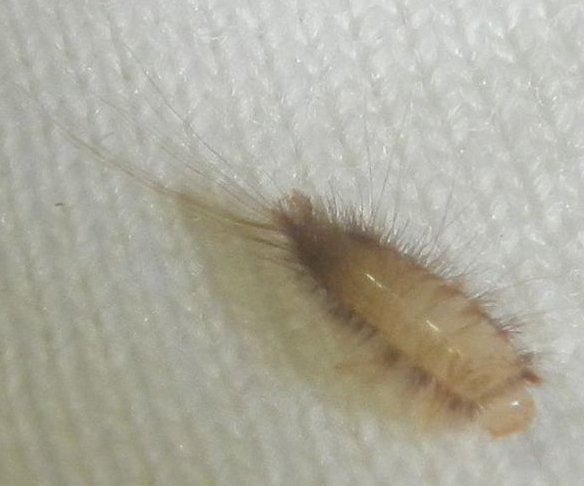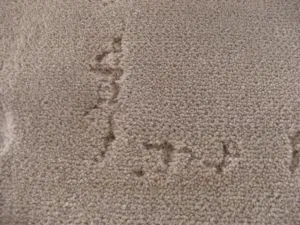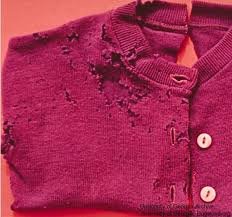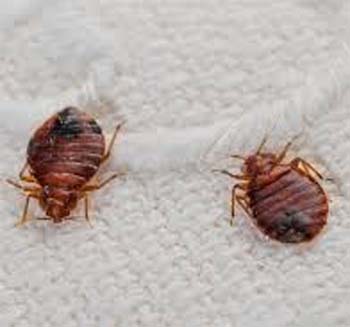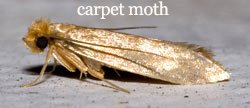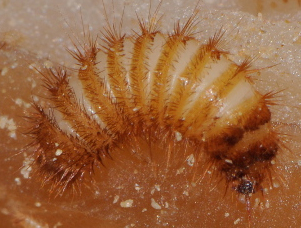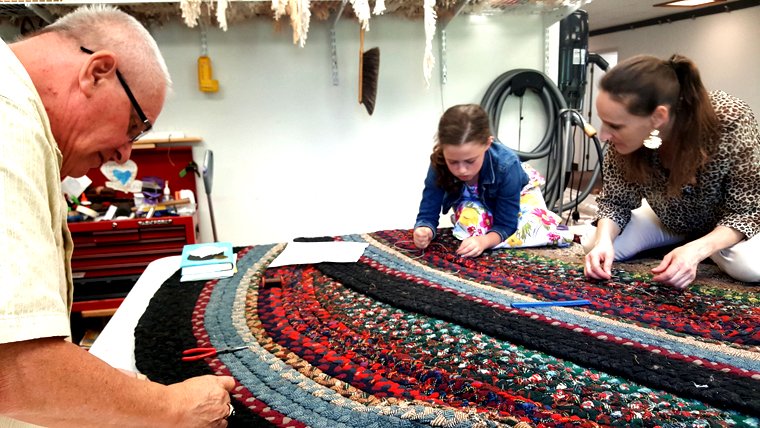CARPET BEETLES
WHAT ARE CARPET BEETLES?
Carpet beetles technically belong to the order of Coleoptera (Beetles) and the Family Dermestidae. The word dermestidae comes from the Greek 'derm' meaning skin and 'edmenai' to eat, literally a skin eater. They are small pests that can cause a large amount of damage if left unattended.
WHY ARE THEY CALLED CARPET BEETLES?
Carpet Beetles got their name because years ago most carpeting was made of wool and was the most common food source for the beetles. Today, most wall-to-wall carpets are made of synthetic fibers and carpet beetles will not feed off fibers which are not natural. (They can, however, cause damage when eating food sources on a synthetic fiber such as urine, sweat, food particles, etc.)
ADULT CARPET BEETLES
Adult carpet beetles themselves feed on pollen from garden plants with white or cream flowers such as Spiraea and Viburnum, as well as Crepe Myrtle and Buckwheat. After mating, the females require the nectar and pollen of these flowers in order to lay eggs.
Adult carpet beetles do not bite and are harmless. They are most often seen in the summer months as they seek sites for egg laying. After she lays her eggs, the female will die.
CARPET BEETLE LARVAE
It is the larvae that causes the damage inside buildings when the adult females seek sites to lay their eggs on likely food sources for their larvae. The larvae are most active in the fall before they hibernate for the winter.
HOW DO THEY GET IN THE HOME?
Although the female beetles will often lay eggs outside in abandoned bee, wasp, and bird nests, they are able to fly well and will come into the home through doors, windows, air vents or cracks and can be brought in accidentally on cut flowers. It is also possible for them to cling to pet hair and your own clothing as well. They have no problem coming down through chimneys, plumbing openings, and electrical conduits as well.
Once in the home, they like dark areas such as closets, behind baseboards, under furniture, under area rugs, and along the edges of wall-to-wall carpet, etc. The larvae will feed on any natural fabrics, such as wool carpets and rugs, wool fibers of any kind, skins, furs, feathers, silk, leather bindings of books, stuffed animals, and more.
DO THE LARVAE BITE?
The larvae of the different types of carpet beetles have long, hard hairs. If contact occurs, a susceptible human could feel as if he or she were bitten. A reaction is usually not serious but can actually build up over time.
If the larvae crawl across a person, the marks the hairs leave will usually appear in a line. The larvae are sometimes known as ‘woolly bears’ (not the caterpillar) and even their shed hair can occasionally lead to a severe human skin irritation known as Carpet Beetle Dermatitis. The hair can also cause reactions in the respiratory tract of some people.
TYPES OF CARPET BEETLES
There are several types of adult carpet beetles. They are oval shaped with 6 legs and 2 antennae. They have rounded, hard bodies and wings beneath their shells. Some have scales of different colors on their wing covers and these can wear off over time. The larvae of most look like fuzzy worms with bands across their bodies and long hair-like extensions on either one or both ends of their bodies.
The four most prevalent types are found all over the world:
- Varied Carpet Beetle- Anthrenus verbasci. This is the most common beetle pest in Europe.
- Black Carpet Beetle- Attagenus unicolor. This is the most common and most destructive in the U.S.
- Furniture Carpet Beetle- Anthrenus flavipes. This beetle is very similar to the Varied Carpet Beetle.
- Common Carpet Beetle-Anthrenus scrophulariae. This beetle is similar to the Varied Carpet Beetle.
LIFE CYCLE OF CARPET BEETLES
Carpet beetles go through a complete metamorphosis. There are 4 stages of development involved:
- Egg
- Immature Larva
- Pupa – Transition Stage from Larva to Adult
- Adult emerging from Pupa
As the larvae grow, as with all insects, they will shed their exoskeletons (skins). This can happen a dozen times or more. The larvae feed in limited areas and these skins, which resemble the larva, will accumulate and may often be one of the more noticeable signs of an infestation. Beetle larvae resemble millipedes but the distinguishing characteristic is the beetle larvae have only 3 pairs of legs.
The life cycle of a carpet beetle is usually completed within a year, especially with the black and varied beetles, though others can have 3 or four generations per year. Depending on the species, the female can lay 40 to 90 eggs in her lifetime. These eggs will hatch into larvae in 10 to 20 days. The larvae may spend 2 months to a year or more in the larval stage, depending on the beetle species, the type and amount of food available, and the temperature. Indoors in warm areas leads to a shorter life cycle than in unheated portions of a home during the winter. The adults will emerge from the pupal stage in the spring.
WHAT DO CARPET BEETLES
LOOK LIKE?
Varied Carpet Beetle (Anthrenus verbasci):
- Adult: These beetles are approximately 1/20th of an inch long and typically oval. Their backs are spotted with grey, yellow, brown, and white scales on their wing covers. These scales are small and in an irregular pattern. They do wear off over time so older adults may appear solid brown or black.
- Larvae: They are approximately 3/16 to ¼ inch long with a series of light and dark-brown stripes running across their body which is covered with dark hair. These larvae have 3 dense tufts of bristles at the rear end which they extend upright to form a round plume if disturbed. In the Pacific Northwest, these usually have a black and yellow or black and blue color pattern. They are distinguishable from other carpet beetle larvae because they are broader in the rear and narrower in the front.
Black Carpet Beetle (Attagenus unicolor):
- Adult: These beetles are less than ¼ inch long and are oval-shaped. They are twice as long as they are wide. They are usually shiny black or dark brown with brown legs, though they may sometimes be a reddish-brown color and they do not have scales over their wing covers.
- Larvae: The larvae of this beetle can grow to as large as ½ inch and range from light brown to almost black in color. They are shiny, smooth, and hard and have short-stiff hairs which cover their body. The body will taper toward the rear and end in a tuft of long hairs. When disturbed they will curl up and ‘play dead.’ In arid areas, the black carpet beetle is a more serious stored-product pest than a fabric pest.
Furniture Carpet Beetle (Anthrenus flavipes):
- Adult: These beetles are slightly larger and rounder than the varied carpet beetle. They have scales that are larger than the varied carpet beetle and they generally have a mottled appearance because of the black spots interspersing with white and dark yellow to orange scales on their wing covers. Adults can appear solid black if their scales have worn off. Their undersides are white.
- Larvae: The larvae of the furniture beetle are white but then mature to a red or chestnut color with brown bands across the body. They are broader in the front and narrower at the rear in contrast to the larvae of the varied carpet beetle.
Common Carpet Beetle (Anthrenus scrophulariae):
- Adult: These beetles have black, white, and red scales. They are also known as Buffalo Carpet Beetles. They are more common in north temperate regions and less common in humid areas.
- Larvae: They are red-brown in color and covered in dark hair.
CAN I ELIMINATE THE PESTS MYSELF?
First of all, just a few beetles in the house shouldn’t be cause for alarm. However, if you find larvae developing in fabrics in your home, you will need to implement some kind of management program.
An infestation of carpet beetles in the home is hard to control because of the variety of food sources available for them in a home and their ability to find food in obscure places.
Over the counter products applied by the homeowner may only serve to repel them and cause them to scatter to other areas of the home.
A serious infestation should warrant a call to a licensed pest control operator.
A WORD OF WARNING!
There are products you can use, but they can be harmful to you, other family members or pets. Do-it-yourself ways include:
- Insecticides. Insecticides should contain as the active ingredient either permethrin, bifenthrin, deltamethrin, cypermethrin, talomethrin and/or related compounds. Never use insecticides around open flames, sparks, or electrical circuits or spray them on asphalt or tile floors. Linoleum floors should be avoided as well. Insecticide sprays are often of limited use against carpet beetles, since they are often within materials where the sprays cannot penetrate. There is also the risk of contamination and further staining on certain objects.
- Boric acid.
- Diatomaceous earth (food grade). Even ‘food grade’ diatomaceous earth can be harmful when used because of fine dust particles. A respirator or mask is important when using.
- Fogging (not household ‘bug bombs’).
*************************
FIRST STEP - IDENTIFY AND START LOOKING
The first step is to correctly identify the insect and then thoroughly investigate and eliminate the sources of the infestation. If you can successfully identify their food sources, you may be able to get rid of the carpet beetles without calling in an exterminator.
- Many times the beetles can be found congregating around windows and doorways and these might be the best places to check first.
- Using sticky traps by windows and doors is a way of monitoring where the beetles are coming in from. Pheromone traps are also good but they are species-specific so make sure to use one that attracts the species causing your problems.
- Look in areas where lint and hair can tend to accumulate such as areas under carpets and rugs and along carpet edges, under seldom-moved furniture, in floor cracks, registers, and ducts, in folds of upholstered furniture, etc.
- Check stored woolen clothing, wool flannel, and yarn in attics, basements, and closets.
- Items made of fur and hair or feathers and preserved animals may also be sources of egg-laying and feeding.
- Old animal or bird nests attached to buildings and collections of dead insects around windows or behind walls should be checked.
- Carpet beetles can get into cars as well and quickly cause damage. Check under car mats and under car seats.
- Look for any damage. These might include bare spots in rugs, wormholes in books, holes in clothing that has been packed away. The holes in clothing will be much larger than those caused by moths because the larvae tend to stay in limited areas when feeding, thus causing more damage.
- Carpet beetles can occasionally feed on stored products such as certain spices and grains.
- Check felts and hammers inside pianos as well.
- Check underneath lamps with felt or velvet pads.
- Look inside musical instrument cases. Carpet beetles will feed off the felt or velvet lining the case.
- Look inside baits for rodents since they will also feed off the carcasses of dead rodents.
- Animals preserved through taxidermy are also places where the larvae can hide.
- Always check in or on fresh cut flowers and rinse them before arranging. This is a very common way carpet beetles are unknowingly brought into the home.
SPECIFIC TASKS TO PERFORM TO ELIMINATE CARPET BEETLES
- It is important to thoroughly clean out potential breeding sites by removing the insects so get out the duster, broom, and vacuum! Beetle larvae thrive on tufts of pet fur, dust bunnies, cobwebs, and dead insects. A thorough vacuuming, repeated regularly, will help to control the beetles.
- Vacuum along and beneath edges of carpets, along baseboards, underneath furniture and stored items, and inside closets and quiet areas.
- After vacuuming, make sure to dispose of used vacuum bags. Those insects picked up during vacuuming could continue to develop within the collected material.
- Machine washable infested fabrics such as clothing, towels, bedding, cushion covers, and curtains should be washed in hot, soapy water and then exposed to high heat in a clothes drier. This will kill any live insects or eggs.
- If items are not machine-washable or they are too delicate, they must be professionally dry cleaned.
- If possible, deep freezing can be another method for killing these insects and their eggs. Before freezing, items should be placed in plastic bags or wrapped in polyethylene sheeting and sealed with tape. This will prevent frost and ice from forming and condensation after removal.
- In order to kill carpet beetles (and clothes moths as well) by freezing, infested items need to be held at a minimum temperature of 0 degrees F. for at least one week. If the freezer is capable of reaching minus 20 degrees F, all life stages will be killed within 72 hours. After freezing, items should be allowed to return to room temperature for about 24 hours before being further handled. This will help to reduce breakage for items which may become brittle at low temperatures.
- Any items that cannot be exposed to heat or extreme cold or any item that cannot be cleaned thoroughly should be disposed of. Bag heavily infested items before disposal to help prevent further spread of the beetles.
- Schedule to have your wall-to-wall carpet, area rugs, and upholstered furniture thoroughly and professionally cleaned initially and schedule regular follow-up cleanings.
HOW TO AVOID
CARPET BEETLE INFESTATIONS
Of course, the best way to avoid carpet beetle infestations is with prevention! Here are some tips:
- Keep surfaces clean from leftover food, dust, lint, etc.
- Vacuum regularly.
- Mop regularly
- Store any susceptible fabric items in insect-proof containers or at low temperatures around 40 degrees F.
- Seal cracks around edges of windows or doors and check vents and openings under eaves.
- Keep fabrics clean since food and perspiration residues will attract carpet beetles. They will not eat synthetic fabrics unless they are blended with wool or unclean.
- Seal clean stored clothing in airtight containers. Cedar chests will lose their cedar oil as they age so they are not as useful.
- Clean lint traps often and throw the lint outside.
- Have air ducts cleaned.
- If possible, place mounted animal specimens periodically in a freezer for 10 to 14 days.
- Clean crumbs out of pantries and off floors.
- Some varieties of carpet beetle will also infest seeds, cereals, pet food, and other plant-based materials. Keep these items in insect-proof containers.
- Regular scheduling of wall-to-wall carpets, rugs, and upholstered furniture with a professional.
CARPET BEETLES, BED BUGS or MOTHS?
It is fairly easy to distinguish between carpet
beetles, bedbugs, and moths, though their larvae may look similar.
- Adult carpet beetles have rounded, hard bodies with wings beneath their shells and are good fliers. Bedbugs do not have wings and cannot fly. Adult moths, of course, look nothing like carpet beetles or bedbugs.
- Bedbugs will bite and their bodies, when crushed, will contain blood. Moth and carpet beetle larvae do not bite but as mentioned above, certain individuals may be sensitive to the hairs of the carpet beetle larvae and when contact occurs, a rash may develop or respiratory irritation.
- The damage done by moths is similar to that of carpet beetles, but is more widely distributed while the carpet beetle larvae tend to feed together in limited areas causing more damage resulting in larger holes in clothes and other fabrics. Bedbugs do their damage on humans and do not feed off fabrics.
- Moths and carpet beetles go through complete metamorphosis from egg to larva to pupa to adult. Cast-off skins from moths resemble small pieces of white paper. Certain moths also leave webbing. The carpet beetles leave brown, shell-like, bristly-looking cast-off skins when they molt. Bedbugs go through what is called a simple metamorphosis. They go from egg to nymph. The nymph will resemble a miniature adult but it is not able to reproduce. The bedbugs develop during 5 nymph stages and then the adult emerges. There is no pupa stage.
For more information on Moths and Bedbugs, please see these articles on our website:
HOW ABC CAN HELP?
There are several ways we can help with the elimination of carpet beetles:
- Our process of wall-to-wall carpet cleaning and upholstered furniture cleaning will eliminate both eggs and larvae.
- Bring your infested area rugs to our cleaning plant and we will thoroughly treat and clean and eliminate the carpet beetles, their larvae and eggs.
- Please call or text our office with any questions you may have. We are always ready to help in any way we can. Our office hours are Monday through Thursday 8am to 5pm, Fridays 8am to 4:30pm, and Saturdays 10am to 1pm. You may call or text us at 607-272-1566 or email us at info@abcclean.com or rugladyvanessa@gmail.com
"The Cleanest Clean You've Ever Seen."
by
ABC Oriental Rug & Carpet Cleaning Co.
130 Cecil Malone Drive Ithaca, NY 14850
607-272-1566
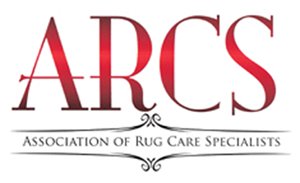
ABC Oriental Rug & Carpet Cleaning Co.
is a FOUNDING MEMBER of the
Association
of Rug Care Specialists.
"To Teach, Cultivate and Advance the Art and Science
of Rug Care"
GIVE THE
GIFT OF CLEAN!

Why not think 'outside the box' and give
a Gift Certificate for professional carpet, upholstery, or tile
& grout cleaning from ABC for any special occasion!
Does a special person have a favorite area rug or oriental rug that needs cleaning or repair? Just give us a call. You'll make their day!
Bring in the mats from a car and we'll clean them as well.
Contact
us if you live in the Ithaca, NY or surrounding areas and we will
tailor a special gift certificate just for you for any Special Occasion.
ABC Oriental Rug is on Facebook!
We regularly post tips and information about your carpet, rugs, upholstery, and tile and grout so please visit us often.
We update our Facebook page with our latest discounts and we are also offering exclusive promotions to our Facebook fans. These are limited and short notice promotions.
When you like our page, you will also be able to claim your special gift from us!
"Like Us"
on Facebook
and find out
what's going on!
Did you know that our ABC Responsible Care Spotter can get those pesky spots out of your carpet and will work equally as well on your clothes and upholstery?
Stop by our office and pick one up. They are $5.00 + Tax but if you have carpets or upholstery cleaned in your home or business, just request a free one from your Technician.
And don't forget to fill out the form above to download your free ABC Spotting Guide!
